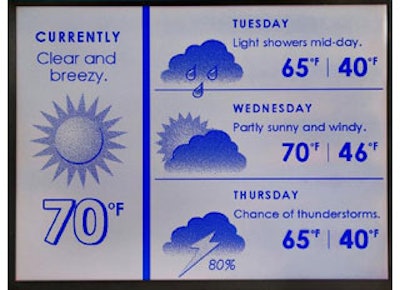
Imagine an LCD Display module that requires no power to display an image even if you leave the image on the screen for two weeks. That seems impossible, right? Well not any longer!
A new display technology called bi-stable or cholesteric liquid crystal display is now a reality and is available to designers of products. The display technology is unique in that it only requires power to change the image on the screen, but does not require any power to hold the image in place indefinitely.
This is the same technology that is being use on the Amazon Kindle and other e-readers. These zero-power displays are now available to OEM (Original Equipment Manufacturers). Their cost and MOQ’s (Minimum Order Quantities) are decreasing as they become more popular. This makes the new technology more and more attractive for consumer products that require minimal power usage.
Is a bi-stable display the right technology for your new product?
To properly answer this question, review the following benefits and shortcomings of this new zero- power display.
Benefits
Cholesteric liquid crystal displays offer an ultra wide viewing angle; in fact, the display is readable from a full 180 degrees. This exceeds the viewing angle of every other type of LCD display. The reason this is possible is because the technology does not require a polarizer. Without the polarizer—which naturally limits viewing angle—this means you can read the display from extreme high, low, left, or right angles.
The display offers a very sharp contrast between the background and the character segments. The contrast is very close to that of printed type on white paper; that is another quality that speaks to its readability. Bi-stable displays are also versatile in that they are not limited to black letters on a white background. The segments can be other colors and the display can run in negative mode. (Negative mode is when the characters are light in color and the background is darker.)
Last, but certainly not least, cholesteric liquid crystal display modules operate great in direct sunlight. In fact, the brighter the ambient light, the easer they are to read.
Disadvantages
Bi-stable displays require the use of a booster or charge pump. There are certain conditions or environments wherein this technology is not recommended. Specifically, it can be dangerous in situations where there may be explosive gas.
At this time, while Bi-stable LCD’s can use a wide range of colors for the background and the segments they are limited to one color of character and one color of background. Unlike TFT (thin-film-transistor) and OLED (organic light emitting diode) displays, which allow the user to display 64,000 or more colors.
There is new technology being developed to add colors as an option to these displays. Research by Gamma Displays (http://gammadynamics.net/) in Tempe Arizona has developed a prototype bi-stable display that is able to produce a multitude of colors. Although this is not in production at this time, it could be incorporated in the next generation of tablets or laptops.
This could mean that tablets and laptop computers could operate for a month or two before needing to be recharged. Can you imagine that!? No more worrying that your battery will run out on a long flight leaving you hanging in the last chapter of your book or without saving that word document you’d worked so hard on.
What are some of the possible products this technology could be used in?
A highly functional product in which to use this technology would be the Blood/Glucose testing units for diabetics. It would allow the user to measure their sugar content in the blood and the display would continue to hold the data until changed. The tester could go several years without having to replace the battery.
Another product that would benefit from a bi-stable display would be a thermometer. It would display the patient’s temperature and keep holding that data until changed.
Bi-stable displays can be customized to meet design requirements.
For more information, visit www.focuslcd.com.


















